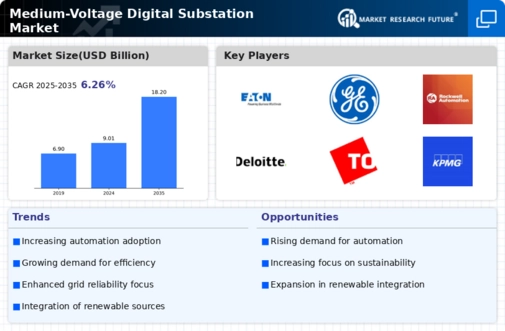Increased Focus on Grid Resilience
The increased focus on grid resilience is shaping the Medium-Voltage Digital Substation Market. With the growing frequency of extreme weather events and other disruptions, utilities are prioritizing the enhancement of grid reliability and resilience. Digital substations offer advanced features such as real-time monitoring and predictive maintenance, which can significantly reduce the risk of outages. The market is likely to see a rise in investments aimed at upgrading existing infrastructure to incorporate these technologies. According to recent studies, utilities that invest in digital solutions can achieve a reduction in operational costs by up to 20%, highlighting the economic benefits of modernizing the Medium-Voltage Digital Substation Market.
Rising Demand for Renewable Energy
The increasing emphasis on renewable energy sources is driving the Medium-Voltage Digital Substation Market. As countries strive to meet their energy needs sustainably, the integration of renewable energy sources such as wind and solar power into the grid becomes essential. This transition necessitates the modernization of substations to handle variable energy inputs efficiently. The Medium-Voltage Digital Substation Market is likely to benefit from this shift, as digital substations can enhance grid reliability and facilitate the integration of distributed energy resources. Furthermore, the International Energy Agency projects that renewable energy will account for a significant portion of the global energy mix by 2030, further underscoring the need for advanced substation technologies.
Government Initiatives and Regulations
Government initiatives and regulations aimed at modernizing electrical infrastructure are propelling the Medium-Voltage Digital Substation Market. Many governments are implementing policies that encourage the adoption of smart grid technologies and digital substations to enhance energy efficiency and reliability. These initiatives often include financial incentives, grants, and subsidies for utilities investing in modern infrastructure. As a result, the Medium-Voltage Digital Substation Market is likely to experience growth driven by supportive regulatory frameworks. The increasing focus on energy security and resilience further emphasizes the importance of upgrading substations to meet contemporary demands.
Growing Urbanization and Electrification
The trend of growing urbanization and electrification is a key driver for the Medium-Voltage Digital Substation Market. As urban areas expand, the demand for reliable and efficient electrical infrastructure intensifies. Digital substations play a crucial role in meeting the energy demands of densely populated regions by providing enhanced monitoring and control capabilities. The World Bank estimates that urban populations will continue to rise, leading to increased electricity consumption. This scenario presents a substantial opportunity for the Medium-Voltage Digital Substation Market to innovate and provide solutions that cater to the evolving needs of urban centers.
Technological Advancements in Automation
Technological advancements in automation are significantly influencing the Medium-Voltage Digital Substation Market. The adoption of automated systems allows for improved monitoring, control, and management of electrical networks. These advancements enable utilities to optimize operations, reduce downtime, and enhance overall efficiency. The market is witnessing a surge in the deployment of digital substations equipped with advanced sensors and communication technologies. According to industry reports, the automation segment is expected to grow at a compound annual growth rate of over 10% in the coming years, indicating a robust demand for innovative solutions within the Medium-Voltage Digital Substation Market.


















Leave a Comment